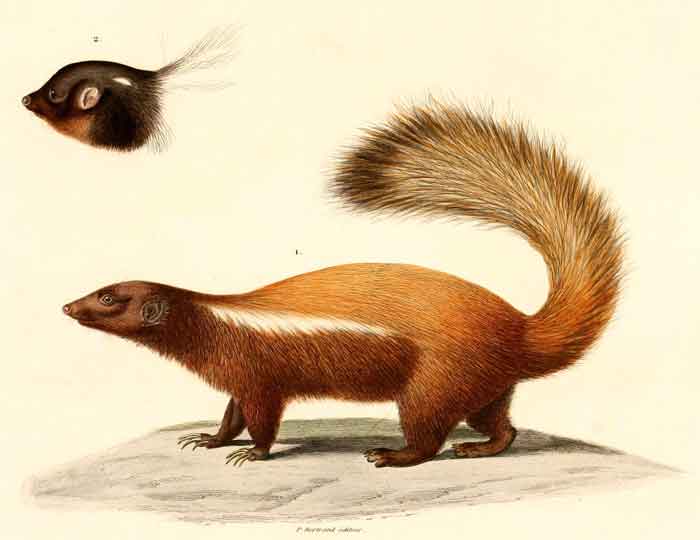
Superregnum: Eukaryota
Cladus: Unikonta
Cladus: Opisthokonta
Cladus: Holozoa
Regnum: Animalia
Subregnum: Eumetazoa
Cladus: Bilateria
Cladus: Nephrozoa
Superphylum: Deuterostomia
Phylum: Chordata
Subphylum: Vertebrata
Infraphylum: Gnathostomata
Megaclassis: Osteichthyes
Cladus: Sarcopterygii
Cladus: Rhipidistia
Cladus: Tetrapodomorpha
Cladus: Eotetrapodiformes
Cladus: Elpistostegalia
Superclassis: Tetrapoda
Cladus: Reptiliomorpha
Cladus: Amniota
Cladus: Synapsida
Cladus: Eupelycosauria
Cladus: Sphenacodontia
Cladus: Sphenacodontoidea
Cladus: Therapsida
Cladus: Theriodontia
Cladus: Cynodontia
Cladus: Eucynodontia
Cladus: Probainognathia
Cladus: Prozostrodontia
Cladus: Mammaliaformes
Classis: Mammalia
Subclassis: Trechnotheria
Infraclassis: Zatheria
Supercohors: Theria
Cohors: Eutheria
Infraclassis: Placentalia
Cladus: Boreoeutheria
Superordo: Laurasiatheria
Cladus: Scrotifera
Cladus: Ferungulata
Cladus: Ferae
Cladus: Pancarnivora
Cladus: Carnivoramorpha
Cladus: Carnivoraformes
Ordo: Carnivora
Subordo: Caniformia
Infraordo: Arctoidea
Superfamilia: Musteloidea
Familia: Mephitidae
Genus: Conepatus
Species: Conepatus humboldtii
Subspecies: C. h. castaneus - C. h. humboldtii - C. h. proteus
Name
Conepatus humboldtii Gray, 1837
Type locality: "Magellan Straits." [Chile].
References
Mag. Nat. Hist. [Charlesworth's], 1: 581.
Conepatus humboldtii in Mammal Species of the World.
Wilson, Don E. & Reeder, DeeAnn M. (Editors) 2005. Mammal Species of the World – A Taxonomic and Geographic Reference. Third edition. ISBN 0-8018-8221-4.
Conepatus humboldtii Gray, 1837 – Taxon details on Integrated Taxonomic Information System (ITIS).
IUCN: Conepatus humboldtii Gray, 1837 (Least Concern)
Vernacular names
English: Humboldt's Hog-nosed Skunk
español: Zorrino de la Patagonia
polski: Surillo patagoński
português: Zorrilho-da-Patagônia
Türkçe: Humbodlt domuz burunlu kokarcası
Humboldt's hog-nosed skunk (Conepatus humboldtii), also known as the Patagonian hog-nosed skunk, is a species of hog-nosed skunk indigenous to the open grassy areas in the Patagonian regions of South Argentina and Chile. It belongs to the order Carnivora and the family Mephitidae.
Appearance and anatomy
This skunk is small and stocky, with a bare nose elongated for the purpose of finding ground beetles, grasshoppers and crickets.[3] Its fur is brownish-red with two symmetrical stripes on either side, extending to the tail. It ranges from 30 to 34 cm in body length, with a 17- to 21-cm tail. They usually weigh 1.5 to 3.0 kg. The skunk has long claws and well developed forelimbs in order to dig to locate prey.[3]
Its teeth are specialized for the consumption of invertebrates and fruit, their lower molars are adapted for crushing such resistant foods. Similar adaptation of the molars is seen in the South American gray fox.[3] Like all South American hog-nosed skunks, it is smaller with a more primitive skull and tooth structure than North American skunks.[4]
Habitat and ecology
There is high pressure from intraguild predation on Humboldt's hog-nosed skunks. It is often preyed upon and targeted competitively by larger carnivorans such as the culpeo, chilla fox, Geoffrey's cat, pampas cat, Andean cat, and puma. It, however, is unlikely to target other carnivorans.[5]
Diet
Humboldt's hog-nosed skunks are omnivorous, feeding primarily on insects but also on vertebrate prey, such as rodents and carrion during winters, when insects are less abundant.[3] Patagonian hog nosed skunks have also been known to eat fruit.[3]
Unlike other South American carnivorans, it is less effected by competition from increased dietary homogenization in areas where native prey species have gone extinct due to its largely strictly insectivorous diet.[6]
Behavior
Humboldt's hog-nosed skunks are crepuscular, active primarily at dawn and twilight. It does little in the way of active hunting, selecting prey that is easiest to capture. During the winter seasons, it shifts from its open grassy habitats to shrubs, forests, and mountainous areas as insect populations decline to seek alternative food sources.[3]
Taxonomic status
John Edward Gray named the species in honor of Alexander von Humboldt.[7]
C. humboldtii's and C. chinga's status as separate species is debated. There is a high degree of observed variation in coloration and pattern within the two species and observed differences are inconsistent.[8] Much of the variation in shape and size observed can be attributed to environmental influence.[8] Morphological comparisons also show a wide overlap in skull and mandibular structure.[8] In 2021, the American Society of Mammalogists considered C. humboldtii conspecific with C. chinga.[9]
References
Emmons, L.; Helgen, K. (2016). "Conepatus humboldtii". IUCN Red List of Threatened Species. 2016: e.T41631A45210677. doi:10.2305/IUCN.UK.2016-1.RLTS.T41631A45210677.en. Retrieved 12 November 2021.
"Appendices | CITES". cites.org. Retrieved 2022-01-14.
Zapata, Sonia C.; Travaini, Alejandro; Martínez-Peck, Rolando (January 2001), "Seasonal feeding habits of the Patagonian hog-nosed skunk Conepatus humboldtii in southern Patagonia", Acta Theriologica, 46: 97–102
Wang, X., & Carranza-Castañeda, Ó. (2008). Earliest hog-nosed skunk, Conepatus (Mephitidae, Carnivora), from the early Pliocene of Guanajuato, Mexico and origin of South American skunks. Zoological Journal of the Linnean Society, 154(2), 386-407.
Oliveira, T. G., & Pereira, J. A. (2013). Intraguild Predation and Interspecific Killing as Structuring Forces of Carnivoran Communities in South America. Journal of Mammalian Evolution, 21(4), 427-436.
Palacios, R., Walker, R. S., & Novaro, A. J. (2012). Differences in diet and trophic interactions of Patagonian carnivores between areas with mostly native or exotic prey. Mammalian Biology - Zeitschrift für Säugetierkunde, 77(3), 183-189.
Wasmuth, Christopher. "A name to conjure with". The Humboldt Foundation.
Schiaffini, M. I., Gabrielli, M., Prevosti, F. J., Cardoso, Y. P., Castillo, D., Bo, R., . . . Lizarralde, M. (2013). Taxonomic status of southern South American Conepatus (Carnivora: Mephitidae). Zoological Journal of the Linnean Society, 167(2), 327-344.
"Conepatus chinga". ASM Mammal Diversity Database. 1.5. American Society of Mammalogists. Retrieved 1 September 2021.
Retrieved from "http://en.wikipedia.org/"
All text is available under the terms of the GNU Free Documentation License

